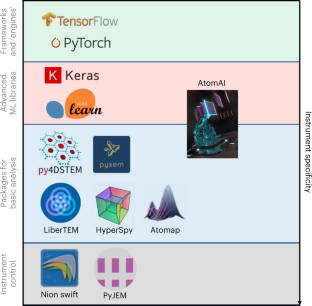2023-04-17 オークリッジ国立研究所(ORNL)
深層学習を使用して原子分解能で顕微鏡データを解析し、試料中の各原子の正確な位置と種類などの物理量を提供する。これにより、研究者は数千個の原子と分子構造の異常を含む数百の画像を含む複雑なデータセットから統計的に有意な情報を迅速に取得できるようになった。材料の量子原子レベルでの精度の高い工学や物理化学的な特性の詳細な理解が可能になる。
AtomAIは、ブラウザから全体を起動し、コーディングの知識を最小限に抑えることができるため、容易にアクセスできるように設計されている。
<関連情報>
- https://www.ornl.gov/news/deep-learning-based-data-analysis-software-ornl-promises-accelerate-materials-research
- https://www.nature.com/articles/s42256-022-00555-8
電子顕微鏡・走査型プローブ顕微鏡における画像・分光データの深層学習解析のためのAtomAIフレームワーク。 AtomAI framework for deep learning analysis of image and spectroscopy data in electron and scanning probe microscopy
Maxim Ziatdinov,Ayana Ghosh,Chun Yin (Tommy) Wong & Sergei V. Kalinin
Nature Machine Intelligence Published:08 December 2022
DOI:https://doi.org/10.1038/s42256-022-00555-8

Abstract
Over the past several decades, electron and scanning probe microscopes have become critical components of condensed matter physics, materials science and chemistry research. At the same time, the infrastructure for establishing a connection between microscopy observations and materials behaviour over a broader parameter space is lacking. Here we introduce AtomAI, an open-source software package bridging instrument-specific Python libraries, deep learning and simulation tools into a single ecosystem. AtomAI allows direct applications of deep neural networks for atomic and mesoscopic image segmentation converting image and spectroscopy data into class-based local descriptors for downstream tasks such as statistical and graph analysis. For atomically resolved imaging data, the output is types and positions of atomic species, with an option for subsequent refinement. AtomAI further allows the implementation of a broad range of image and spectrum analysis functions, including invariant variational autoencoders for disentangling structural factors of variation and im2spec type of encoder–decoder models for mapping structure–property relationships. Finally, our framework allows seamless connection to the first principles modelling with a Python interface on the inferred atomic positions.



